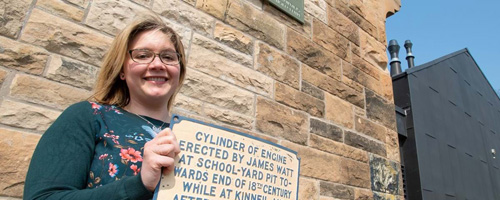 An exhibition dedicated to the life, work and legacy of Scottish engineer and inventor James Watt opens at The Engine Shed in Stirling on 25 April to celebrate the 250th anniversary of his invention of the condenser engine.
An exhibition dedicated to the life, work and legacy of Scottish engineer and inventor James Watt opens at The Engine Shed in Stirling on 25 April to celebrate the 250th anniversary of his invention of the condenser engine.
The exhibition will focus on James Watt’s improvements to the steam engine and features historic artefacts including what might be an example of William Murdoch’s locomotive – on loan from The Stirling Smith Art Gallery and Museum. The exhibition will also showcase two examples of Cartwheel pennies, and a sign from Kinneil House where James Watt developed his prototype steam engine.
On display for the first time since 2000, the locomotive is a replica of what is possibly one of the experimental steam carriages created by William Murdoch in defiance of James Watt’s 1782 patent.
The George III Cartwheel penny, dated 1797, was the first copper penny to be circulated in Britain and the first coin in England to be minted on a steam powered press, developed by James Watt and Matthew Boulton. The sign exhibited is a painted copper alloy plaque from an engine cylinder at Kinneil House.
Visitors will discover the impact James Watt’s invention had on Britain’s industry and engineering, which is still evident today.
The Engine Shed, part of Historic Environment Scotland (HES), serves as a central hub for building and conservation professionals and the general public.
Mark Watson, Deputy Head of Industrial Heritage at Historic Environment Scotland, said: “This exhibition is the perfect way to celebrate the work of James Watt on the 250th anniversary of his patent for the separate steam condenser. This exhibition shines a spotlight on Scotland’s ground-breaking inventor while looking at the impact of his work from the industrial revolution to climate change.”
James Watt: Power to the World’ is free to visit from 10am – 4pm Monday – Saturday and is on display until Friday 23 August.
